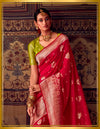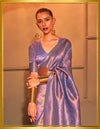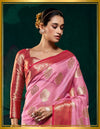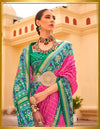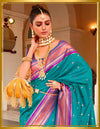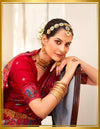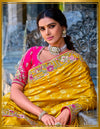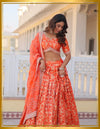What is Korvai Kanjivaram Silk Sarees | Meaning Explained!
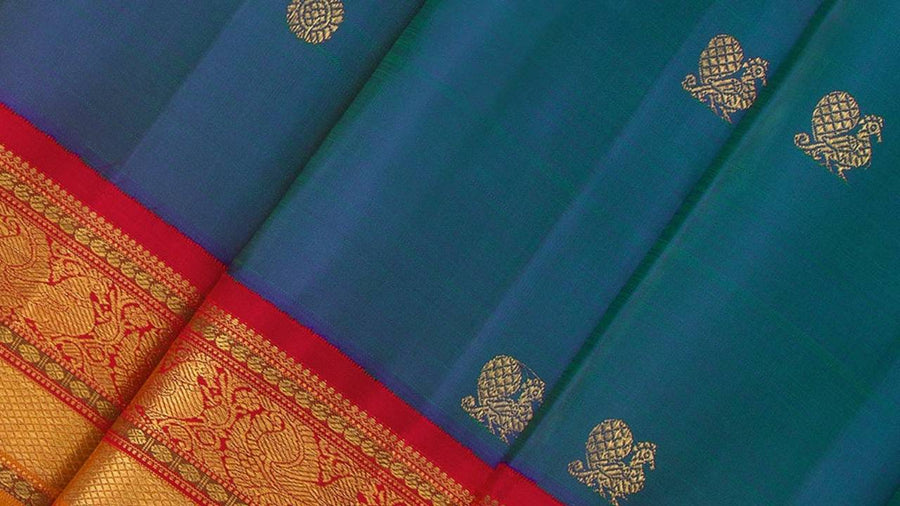
Hailing From the Temple town of Kanchipuram, Tamil Nadu, the Korvai Kanjeevaram sarees are known for their striking borders that contrast beautifully with their bodies. But what sets Korvai sarees apart is the weaving technique.
What Does Korvai Mean?
Korvai means "Joining" or "Sync" in Tamil, and it perfectly describes the unique method that is used to weave Korvai silk sarees.
The magic of the Korvai technique lies in how two weavers work together on a single saree. One weaver focuses on the saree’s body, while the other handles the border. This collaborative method involves interlocking the border and body threads seamlessly which creates a visual and structural distinction that defines the Korvai saree.

Simple Korvai and Rekku Korvai
Not all Korvai sarees are made equal. A Korvai saree style reflects the weaver’s skill and also the occasion for which the saree is crafted.
Simple Korvai
Just like their name suggests, Simple Korvai sarees are designed with simple patterns and borders that complement the saree’s body without overwhelming it. These sarees are ideal for formal or casual gatherings, festivals like Diwali, Dasara, and Sankranthi, or even everyday wear.
Rekku Korvai

Rekku Korvai sarees are where you can see the skill and technique of the weaver. The beautifully patterned edges of the border create a dramatic contrast with the saree’s body which makes it perfect for Weddings, Temple visits, and other grand occasions.
Rekku borders are crafted in three distinct styles. The Thalamppu Rekku features broader temple motifs connecting the border and the body of the saree. The Gopuram Rekku is characterized by patterns inspired by temple architecture. The Seepu Rekku is designed with a comb-like pattern and is a classic style often seen in vintage Kanjivaram sarees.

Cultural Connection of Korvai Kanjivarams
In South India, a Korvai Kanjivaram saree is respected and considered a family treasure and handed down through generations. For Marriages, especially, these korvai sarees are chosen with care.
The thick, contrasting borders with auspicious designs like Temple motifs like Gopuram, Yaali, Maanga, Mayilkan, Poo Chakram, Rudraksha, and Peacock Motifs are believed to bring good fortune. A bride draped in a Rekku Korvai saree during the sacred muhurtam stands as a glowing representation of South Indian tradition.
How to Spot a Genuine Korvai Kanjivaram Saree
With many modern imitations in the market, it is essential to identify a genuine Korvai saree. Here are some tips.
- Border-Body Junction: Just run your fingers over the point where the border meets the body of the saree. Genuine Korvai sarees have an interlocking weave that may even feel slightly uneven which is a mark of authenticity.
- The Weave: Genuine Kanjivaram silk has a very rich texture and is heavier than blended silk and synthetic sarees.
- Handmade Details: Small and irregular details in the zari mean the human touch of skilled weavers which distinguishes it from machine-made silk sarees.
Why Do Korvai Kanjivaram Sarees Matter Today?
In an era of fast fashion, Korvai Kanjeevaram sarees remind us of the beauty of patience and skill. The weavers often learn their craft over the years, with methods passed down through generations. The Kanchi Pattu sarees have a special place in Indian culture that extends beyond their visual appeal. They bring people together, from the weavers who collaborate to create them to the families who cherish and celebrate them.
 New Arrivals
New Arrivals
 Saree Weaves
Saree Weaves
 Banarasi Sarees
Banarasi Sarees
 Kanjivaram Sarees
Kanjivaram Sarees
 Paithani Sarees
Paithani Sarees
 Patola Sarees
Patola Sarees
 Organza Sarees
Organza Sarees
 Chikankari Sarees
Chikankari Sarees
 Kashmiri Jamawar Sarees
Kashmiri Jamawar Sarees
 Dola Silk Sarees
Dola Silk Sarees
 Dharmavaram Silk Sarees
Dharmavaram Silk Sarees
 Saree Fabric
Saree Fabric
 Silk Sarees
Silk Sarees
 Soft Silk Sarees
Soft Silk Sarees
 Linen Sarees
Linen Sarees
 Satin Sarees
Satin Sarees
 Digital Printed Sarees
Digital Printed Sarees
 Tissue Silk Sarees
Tissue Silk Sarees
 Occasion
Occasion
 Festive Wear Sarees
Festive Wear Sarees
 Office Wear Sarees
Office Wear Sarees
 Party Wear Sarees
Party Wear Sarees
 Luxe Collection
Luxe Collection
 Wedding Collection
Wedding Collection
 Engagement Sarees
Engagement Sarees
 Haldi Sarees
Haldi Sarees
 Sangeet Sarees
Sangeet Sarees
 Wedding Banarasi Sarees
Wedding Banarasi Sarees
 Wedding Kanjivaram Sarees
Wedding Kanjivaram Sarees
 Wedding Organza Sarees
Wedding Organza Sarees
 Wedding Patola Sarees
Wedding Patola Sarees
 Sarees By Color
Sarees By Color
 Price Range
Price Range
 Designer Silk Sarees
Designer Silk Sarees
 Track Your Order
Track Your Order
